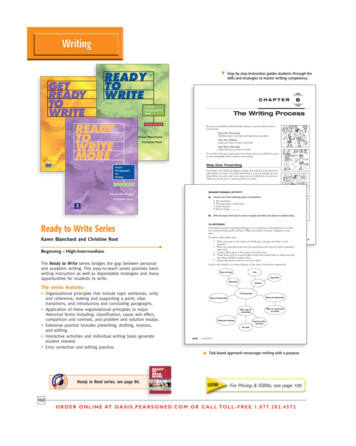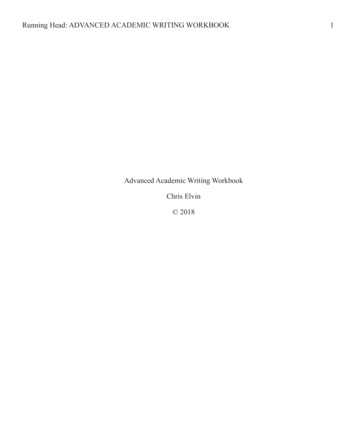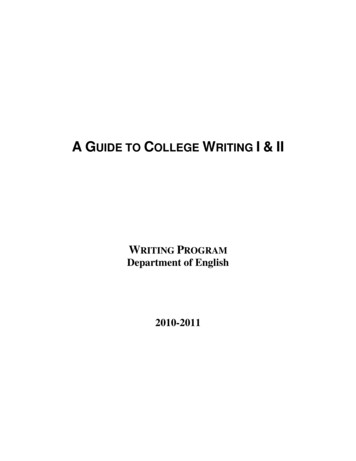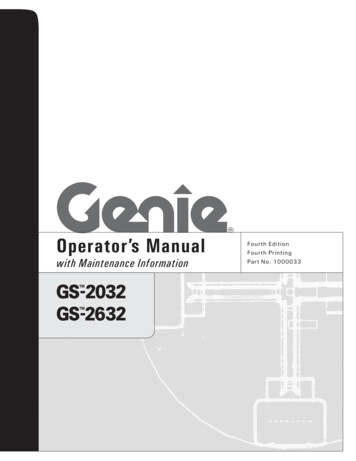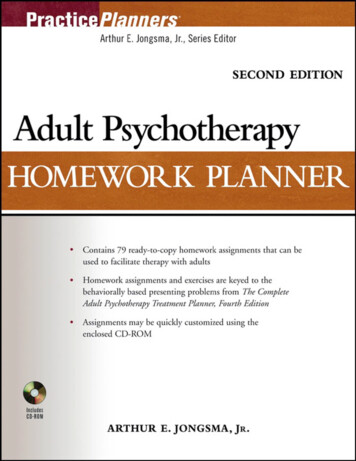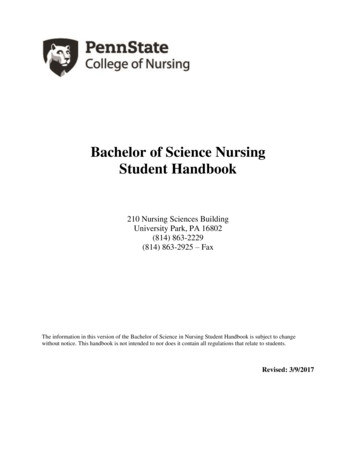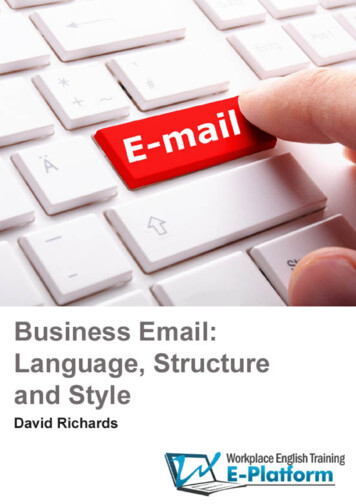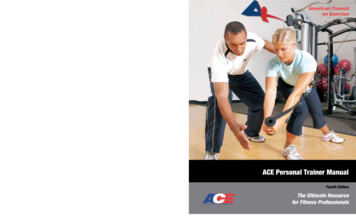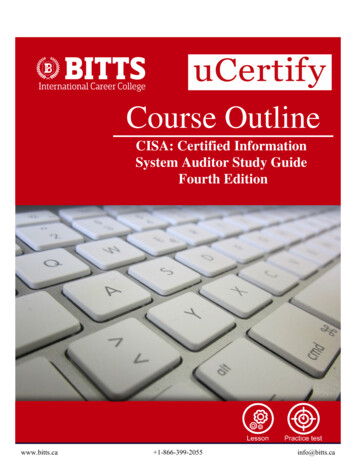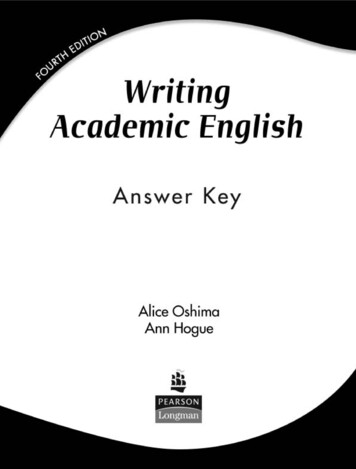
Transcription
Writing Academic English, Fourth EditionAnswer KeyCopyright 2006 by Pearson Education, Inc.All rights reserved.No part of this publication may be reproduced, stored in a retrieval system, or transmitted in any formor by any means, electronic, mechanical, photocopying, recording, or otherwise, without the priorpermission of the publisher.Pearson Education, 10 Bank Street, White Plains, NY 10606Staff credits: The people who made up the Writing Academic English, Fourth Edition, Answer Keyteam, representing editorial, production, design, and manufacturing, are: Christine Edmonds,Nancy Flaggman, Dana Klinek, Laura Lazzaretti, Laura Le Dréan, and Molly Sackler.Text composition: Rainbow GraphicsText font: Times 11.5/14.5LONGMAN O N T H E W EBLongman.com offers online resources forteachers and students. Access our CompanionWebsites, our online catalog, and our localoffices around the world.Visit us at longman.com.ISBN: 0-13-194701-XPrinted in the United States of America1 2 3 4 5 6 7 8 9 10–OPM–09 08 07 06 05
ContentsChapter 1: Paragraph Structure . . . . . . . . . . . . . . . . . . . . . . . . . . . . . . . . . . . . 1Chapter 2: Unity and Coherence . . . . . . . . . . . . . . . . . . . . . . . . . . . . . . . . . . . . 4Chapter 3: Supporting Details: Facts, Quotations, and Statistics . . . . . . . . . 8Chapter 4: From Paragraph to Essay . . . . . . . . . . . . . . . . . . . . . . . . . . . . . . . 11Chapter 5: Chronological Order: Process Essays . . . . . . . . . . . . . . . . . . . . . 16Chapter 6: Cause/Effect Essays . . . . . . . . . . . . . . . . . . . . . . . . . . . . . . . . . . . . 18Chapter 7: Comparison/Contrast Essays . . . . . . . . . . . . . . . . . . . . . . . . . . . . 22Chapter 8: Paraphrase and Summary . . . . . . . . . . . . . . . . . . . . . . . . . . . . . . 25Chapter 9: Argumentative Essays . . . . . . . . . . . . . . . . . . . . . . . . . . . . . . . . . . 27Chapter 10: Types of Sentences . . . . . . . . . . . . . . . . . . . . . . . . . . . . . . . . . . . . 30Chapter 11: Using Parallel Structures and Fixing Sentence Problems . . . 35Chapter 12: Noun Clauses . . . . . . . . . . . . . . . . . . . . . . . . . . . . . . . . . . . . . . . . 41Chapter 13: Adverb Clauses . . . . . . . . . . . . . . . . . . . . . . . . . . . . . . . . . . . . . . 43Chapter 14: Adjective Clauses . . . . . . . . . . . . . . . . . . . . . . . . . . . . . . . . . . . . . 47Chapter 15: Participial Phrases . . . . . . . . . . . . . . . . . . . . . . . . . . . . . . . . . . . . 52Appendix B: Punctuation Rules . . . . . . . . . . . . . . . . . . . . . . . . . . . . . . . . . . . . 55Appendix E: Research and Documentation of Sources . . . . . . . . . . . . . . . . 58
Chapter 1: Paragraph StructureWriting Technique Questions, “Gold” (page 3)1. Gold.2. Gold is beautiful and useful.3. In the first and last sentences.4. Beautiful—Macedonian coin; useful—photography, dentistry, astronauts’ suits.Practice l: Recognizing Topic Sentences (pages 6–8)A. Group 2a. too generalb. too specificc. inc. sent.d. best TSGroup 3a. best TSb. too specificc. too specificd. inc. sent.e. too generalGroup 4a. inc. sent.b. too generalc. too specificd. best TSGroup 5a. too specificb. too generalc. best TSd. too generale. inc. sent.B. Paragraph 1: fParagraph 2: cParagraph 3: dParagraph 4: bPractice 2: Identifying the Parts of a Topic Sentence (page 9)The topic is circled and the controlling idea is underlined.2. (Driving on freeways) requires strong nerves.3. (Driving on freeways) requires an aggressive attitude.4. (The Caribbean island of Trinidad) attracts tourists because of its calypso music.5. Spectacular beaches make (Puerto Rico) a tourist paradise.6. (Moving away from home) can be a stressful experience for young people.7. (Many religious rules) arose from the health needs of ancient times.8. (A major problem for many students) is the high cost of tuition and books.1
9.10.11.12.13.Participating in class discussions is (a problem for several different groups of students).In my opinion, (television commercials for cosmetics) lie to women.(Owning an automobile) is a necessity for me.It is an expensive luxury (to own an automobile in a large city).Taste and appearance are both important in (Japanese cuisine).Practice 3: Writing Topic Sentences (pages 10–11)A. Answers will vary. Examples:Paragraph 1: English contains many foreign words. OR Words of foreign origin haveenriched English.Paragraph 2: The European and North American university systems have severalimportant differences. OR The North American university system is different fromthe European system.Paragraph 3: House construction worldwide depends on the most available nativematerials. OR Every region of the world has its indigenous (native) materials forbuilding houses.B. and C. Individual responses.Practice 4: Supporting Sentences (pages 11–12)Step 2. Although some people think red-light running is a minor traffic violation that is noworse than jaywalking, it can, in fact, become a deadly crime. Topic: red-lightrunning. Controlling idea: It can become a deadly crime.Step 3. An example: sentence 5; a statistic: sentence 3; a quotation: sentence 7Writing Technique Questions, “Language and Perception” (page 13)1. Main idea: Our language influences our perception. Part of topic sentence that expressesthe main idea: “. . . our perception of the world depends to a great extent on thelanguage we speak.”2. Examples: Eskimo languages have as many as 32 words for snow; falling snow, snow onthe ground, snow packed as hard as ice, slushy snow, wind-driven snow; Aztec languagehas one word for snow, cold, and ice.3. A classic example; for instanceWriting Technique Questions, “Concluding Sentences” (page 15)1. The first paragraph—“Greeting Cards”2. The second paragraph—“A Hawaiian Legend”3. In short; This story is a good example.2
Practice 5: Writing Concluding Sentences (pages 15–16)Answers will vary. Examples:Paragraph 1Topic sentence: You can be a good conversationalist by being a good listener.Concluding sentence: In summary, meaningful communication means using both goodfacial expressions and body language as well as showing interest in the speaker’swords.Paragraph 2Topic sentence: Modern communication technology is driving workers in the corporateworld crazy.Concluding sentence: Indeed, faster communication technology may be creating moreproblems than workers can handle.3
Chapter 2: Unity and CoherencePractice 1: Unity (pages 19–21)A. 1. Paragraph 2 has unity.2. Paragraph 1 does not have unity because it discusses 2 topics: (1) biological reactionscaused by color that change our behavior, and (2) religious significance of colors.3. Paragraph 3 does not have unity because it has sentences that are off the topic. (“Blueis not a good color for dinnerware, however. Food looks less appetizing when it isserved on blue plates, perhaps because very few foods in nature are of that color.”)B. Paragraph 1Topic sentence: Adventure travel is the hot trend in the tourism industry.Cross out: People of all ages are choosing educational study tours for their vacations.Paragraph 2Topic sentence: Daredevil sports are also becoming popular.Cross out: Soccer is also popular in the United States now, although football is stillmore popular.C. Paragraph 1First topic sentence: Because the Internet makes the world a smaller place, the valueof having a common language is greatly increased.Cross out: His company spends 200 million a year translating software into otherlanguages.Second topic sentence: Someday, software may be available to instantly translateboth written and spoken language so well that the need for any common languagecould decline.Cross out: Computer spelling checkers also exist for various languages.Paragraph 2First topic sentence: Even when you try to be polite, it is easy to do the wrong thinginadvertently in a new culture.Cross out: Meals in the United States are usually more informal than meals in othercountries, and the times of meals may be different.Second topic sentence: Although North Americans are usually very direct in socialmatters, there are a few occasions when they are not.Cross out: Idioms are often difficult for newcomers to understand.Practice 2: Repetition of Key Nouns (page 23)Responses will vary.Practice 3: Key Noun Substitutes (page 24)Step 1. Key noun: throwStep 2. (a) Key nouns: throw (sentences 1, 5, 6), krewe (sentences 3, 4, 5, 7); (b) Pronouns:them (sentence 6), them (sentence 7), they (sentence 9); (c) Synonyms: souvenir(sentence 3), trinkets (sentence 4), trinkets (sentence 5), memento (sentence 8)4
Practice 4: Using Consistent Pronouns (page 25)Olympic athletes must be strong both physically and mentally. First of all, if (they) hope tocompete in an Olympic sport, (they) must be physically strong. Furthermore, aspiringOlympians must train rigorously for many years. For the most demanding sports, (they) trainseveral hours a day, five or six days a week, for ten or more years. In addition to beingphysically strong, athletes must also be mentally tough. This means that (they) have to betotally dedicated to (their) sport, often giving up a normal school, family, and social life.Being mentally strong also means that (they) must be able to withstand the intense pressureof international competition with its accompanying media coverage. Finally, not everyonecan win a medal, so Olympians must possess the inner strength to live with defeat.Practice 5: Transition Signals (pages 25–26)Paragraph 2 is more coherent than paragraph 1.Transition signals in paragraph 2: For example; There are two reasons for this; First of all;therefore; Second; consequently; on the other hand; FurthermorePractice 6: Recognizing Transition Signals (pages 29–30)Genetic research has produced both exciting and frightening possibilities. Scientists are nowable to create new forms of life in the laboratory because of the development of genesplicing. (On the one hand), the ability to create life in the laboratory could greatly benefithumankind. One beneficial application of gene splicing is in agriculture. (For example),researchers have engineered a more nutritious type of rice that could help alleviate theserious problem of vitamin A deficiency. It is estimated that 124 million children worldwidelack vitamin A, putting them at risk of permanent blindness and other health issues.(In addition), genetic engineers have created larger fish, frost-resistant strawberries, andcows that produce more milk. (Indeed), agriculture has already benefited from the promiseof genetic engineering.(On the other hand), not everyone is positive about gene-splicing technology. Some peoplefeel that it could have terrible consequences. (In fact), a type of corn engineered to kill acertain insect pest also threatened to annihilate desirable monarch butterflies. In anotheraccident, a genetically engineered type of corn that was approved only for animalconsumption because it was toxic to humans accidentally cross-pollinated with corn grownfor humans. (As a result), many countries banned imports of genetically modified corn forseveral years. (Furthermore), the ability to clone human beings is a possibility that frightensmany people. In 2004, two South Korean scientists reported that they had successfullycloned a human embryo. The embryo did not develop into a baby; however, it is possiblethat one could do so in the future, a possibility that not everyone is comfortable with.5
Practice 7: Choosing Transition Signals (pages 30–31)A. 2. . . . to find; however,/ . . . to find. However,3. . . . of inflation; therefore,/ . . . of inflation. Therefore,4. . . . it; for example,/ . . . it. For example,5. . . . Earth; therefore/ . . . Earth. Therefore,6. . . . is shallow; as a result, / . . . is shallow. As a result,B. Responses will vary. Suggested answers:1. In fact,2. Also,3. For example,4. Similarly,5. Second,6. third7. Indeed,8. final and most convincingC. Responses will vary. Suggested answers:1. another2. First,3. in contrast,4. second5. In addition,6. As a result,7. Clearly,Practice 8: Using Transition Signals (page 32)Responses will vary.Practice 9: Too Many Transition Signals (page 33)Responses will vary.Practice 10: Recognizing Kinds of Logical Orders (pages 34–36)Paragraph 1: Chronological order. Transition signals: for example, first, Next, After that,FinallyParagraph 2: Comparison and contrast. Transition signals: for example, Furthermore, on theother hand, another, in contrast, but, In addition, whereas, Another, howeverParagraph 3: Chronological order. Transition signals: In about 700 B.C.E., A few decadeslater, Then in 46 B.C.E., The very next, By 1580, in 1582.Paragraph 4: Logical division of ideas. Transition signals: The first kind, A second kind,however, a third kind.6
Practice 11: Review of Coherence (page 37 and pages 7–8)Paragraph 2a. SS2b. SS5 or SS4c. TSd. SS4 or SS5e. SS1f. SS3Paragraph 3a. SS3b. SS1c. SS5d. TSe. SS2f. SS4Paragraph 4a. SS4b. TSc. SS3d. SS5e. SS1f. SS2g. SS67
Chapter 3: Supporting Details: Facts, Quotations, and StatisticsPractice 1: Specific Supporting Details (pages 40–41)Step 2 answers will vary. Sample answers are given in parentheses.4. O(Cost of identity theft; examples of financial ruin caused)5. F–NP(Statistics on number of cases in last few years)6. SSD7. F–NP(Statistics on number of cases not reported)8. SSD9. F–NP(Example of “ordinary people” who are victims)10. SSD11. O or F–NP(Describe methods)12. F–NP13. F–NP(Statistics on ages of victims)14. SSD15. O(List specific actions the police could do; quotation from a victimdemanding police take action)16. SSD17. F–NP(Examples of gangs; statistics; quotation from an authority—police, FBI, etc.)Writing Technique Questions, “Drugs and the Olympic Games 1” (page 43)1. Sentence 1 states the main idea.2. Supporting direct quotation: “From the brute steroids the East Germans reportedly usedon their Olympians during the Cold War to today’s man-made versions of natural humanproteins, drugs have been as much a staple of the Games as gold, silver, and bronze.”Phrase that introduces the direct quotation: “According to an article in Forbes magazine”3. Main idea: It seems apparent that if athletes want to win, they must consider using drugs.The three direct quotations that support it are (1) “If you are especially gifted, you maywin once, but from my experience you can’t continue to win without drugs. The field isjust too filled with drug users.” (2) “a large percentage” (3) “A lot of experts, at least inprivate, feel that way.”4. The verbs are states, believes, and claims.5. Charles Yesalis spoke the words in quotation marks.A person named Herper wrote the article.The article is from an online source. The abbreviation “par.” tells you.Practice 2: Punctuating Direct Quotations (page 46)1. Dr. Yixuan Ma, a well-known astrophysicist who has been studying black holes, said,“They are the most interesting phenomena we astrophysicists have ever studied.”2. As she explained, “In black holes, the laws of nature do not seem to apply.”3. “A black hole is a tiny point with the mass 25 times the mass of our sun,” explained Ma’sassociate, Chun-Yi Su. “Black holes are created by the death of a very large star,”she stated.8
4. “It is an invisible vacuum cleaner in space,” she added, “with tremendous gravitationalpull.”5. According to Dr. Su, “If a person falls into a black hole, he will eventually be crusheddue to the tremendous gravitational forces.”6. “Time will slow down for him as he approaches the point of no return,” she said, “andwhen he reaches the point of no return, time will stand still for him.”Writing Technique Questions, “Drugs and the Olympic Games 2” (page 47)1. The verbs “said” and “stated” are simple past tense.2. Verbs to be underlined: Sentence 6: had prescribed, were, might win, couldn’t continue;Sentence 10: feel. “Feel” is also in the same tense (present). “Had prescribed” is in thesame tense (past perfect). The others are in a different tense—simple past instead ofpresent.3. “He asserted that” has been added. The verb “is” changed to “was.”4. “Athletes” and “they” are in square brackets to show that they have been added by thewriter.5. No.Practice 3: Changing Direct Quotations to Indirect Quotations (page 49)1. Television channel KSA General Manager Jim Burns said that not everyone could attendcollege in the traditional way. Therefore, taking courses via television would offer manymore students the chance to earn a college degree.2. Pre-med student Alma Rodriguez said that she missed being on campus, but (that) shehad to work and take care of her family.3. Other students said that last year they had spent several hours a day commuting to andfrom school. Now they didn’t have to do that.4. Computer engineering student Amir Mehdizadeh stated that he could choose when tostudy and how to study without pressure. He also said that he would take two moretelecourses in the fall.Practice 4: Using Quotations as Support (pages 49–50)Individual paragraphsWriting Technique Questions, “World Population Growth” (page 51)1. Topic sentence: “. . . the world’s population is increasing at a geometric rate.”2. The source is the Population Reference Bureau.3. The phrase According to statistics from . . . identifies the source.Practice 5: Using Statistics (page 52)Responses may vary. Sample response:According to (1) statistics from the Energy Information Administration, world energyconsumption has been steadily (2) rising. Currently, the nations of the world use between (3)404 and (4) 471 quadrillion Btu (British thermal units) annually. By the year 2025,9
consumption is projected to increase to (5) 623 Btu, an increase of (6) 32 percent from theyear (7) 2010. The largest consumers are the (8) industrialized countries, and the nationswho consume the least energy belong to the EE/FSU (Eastern Europe/Former Soviet Union)group. Developing nations consumed approximately the same amount of energy as (9) theEE/FSU countries until (10) 1990, when the energy use of developing nations began to (11)increase. By (12) 2025, it is projected that their use will nearly equal that of (13)industrialized nations.Practice 6: Using Statistics as Support (pages 53–54)Individual paragraphs.10
Chapter 4: From Paragraph to EssayWriting Technique Questions, “Native American Influenceon Modern U.S. Culture” (page 59)1. The essay contains six paragraphs. There are four paragraphs in the body.2. Topic sentences:Body Paragraph 1: First of all, Native Americans left a permanent imprint on theEnglish language.Body Paragraph 2: Art is another area of important Native American contributions.Body Paragraph 3: In addition to language and art, agriculture is another area in whichNative Americans had a great and lasting influence on the peoples who arrived herefrom Europe, Africa, and Asia.Body Paragraph 4: Finally, it may surprise some people to learn that Americans are alsoindebted to the native people for our form of government.3. Native Americans is the key noun. It should be circled five times in body paragraph 1,four times in body paragraph 2, four times in body paragraph 3, once in body paragraph4, and twice in the concluding paragraph.Writing Technique Questions (page 61)1. Funnel: Although not everyone experiences culture shock in exactly the same way, manyexperts agree that it has roughly five stages.Story: The birth of Surtsey, as the island is named, offered scientists an extraordinaryopportunity to learn how life takes hold on a sterile landmass.Surprising: There are so many conflicting news stories about which foods are good foryou that it is often difficult to make the right choices at the supermarket.Historical background: Their ability to adjust to life in their adopted land has dependedon several factors.2. Responses will vary.Practice 1: Introductory Paragraphs (pages 62–63)Paragraph 1: (5) The way people greet each other when they meet for the first time variesfrom culture to culture. (2) In some cultures, people bow, and in others, they shake hands.(3) In English-speaking countries, shaking hands is the custom. (6) How one shakes handssends an important message about one’s character. (1) If done properly, a handshake givesthe impression of strength and honesty, and if done improperly, it conveys weakness anddishonesty. (4) A proper handshake has four ingredients: pressure, pumps, eye contact, andverbal message.Type of introduction: funnel.Paragraph 2: (2) Mr. X went to Mexico from England to manage a milk pasteurization plant.(9) For eight months, he tried every way possible to convince his workers of the importanceof punctuality and of checking every detail of their work. (10) The response was always,“Yes, yes, we will do our best,” but nothing ever changed. (3) Then one day an impressive11
new pasteurization unit arrived and was installed. (1) To celebrate the occasion, Mr. Xdecided to throw a big party at the plant. (4) The employees did most of the planning anddraped the new unit with garlands. (8) The party was a great success and everybody had agood time. (5) During the party one of Mr. X’s supervisors took him aside and said, “Nowwe see that you are buena gente; from now on I am sure everyone will really try to do theirbest for you.” (6) And so it was—neither punctuality nor quality checks were any longerneeded. (7) This story illustrates the need to understand that doing business in a differentculture demands an understanding of the culture.Type of introduction: interesting story.Paragraph 3: Note: The order of sentences 2, 3, and 4 may vary. (2) In 1976, an earthquakein Tangshan, China, killed over 250,000 people. (4) Iran suffered more than 80,000 deaths intwo massive quakes in 1990 and 2003. (3) In an average year, earthquakes kill 10,000 peopleworldwide and cause millions of dollars worth of property damage. (5) Scientists keep tryingto find ways to predict earthquakes—so far without much success. (1) Currently under studyare four main methods for predicting when and where the next Big One will occur.Type of introduction: surprising statistics or facts.Practice 2: Thesis Statements (page 64)A. 1. Chronological order2. Comparison and contrastB. 1. Two paragraphs: increased educational opportunities and changes in the country’slaws2. Four paragraphs: economic independence, political rights, educational opportunities,and social statusPractice 3: Thesis Statements for Logical Division of Ideas (pages 66–67)A. Check sentences 3, 4, 5, 7, and 10.B. 2. [Women generally live longer than men] for two main reasons(:) they tend to takebetter care of their health, and they have better resistance to stress.3. [Teenagers declare their separateness from their parents] by the way they dress(and) by the way they talk.4. In [choosing a major, a student has to consider various factors], (such as) personalinterest, job opportunities, and the availability of training institutions.5. [An architect should be] (both) an artist (and) an engineer.6. [A healthy lifestyle involves] eating a nutritious diet, exercising regularly, (and)getting enough sleep at night.C. Answers will vary. Sample answers:1. communicating with home / professors / classmates, writing papers, doingresearch / group assignments, taking online courses12
2. their inability to see from far away / listen and write at the same time / know what isimportant to write down / understand professors who don’t speak clearly, their lack oflistening skills / English skills / attention3. good speaking ability, personal charm, leadership ability4. my parents’ inability to understand my generation and not live in the past, differencesin how my parents were brought up / in my parents’ culture, issues that my generationhas that didn’t exist in my parents’ generation, a rapidly changing world5. knowing what to do, having a plan, having emergency supplies on hand, followingrecommended procedures, calm attitude6. personality, appearance, intelligence, aptitudes7. cultural attractions, shopping, restaurants, entertainment, public transportation8. language, food, music, literature, art, clothing, house design and decorPractice 4: Writing Logical Division Thesis Statements (page 68)Responses will vary. Sample answers:1. Three clothing styles you can see at my school include hip-hop, prep, and goth.2. There are three types of drivers that make our streets unsafe: speeders, cell-phone users,and teenagers.3. Disneyland and Disney World appeal to both children and adults.4. Living in a small town has several advantages: little traffic, a low crime rate, friendlyneighbors, and community spirit.5. Advertisers design TV car commercials to appeal to shoppers’ different personalities anddesires.Practice 5: Transitions between Paragraphs (pages 70–71)A. Body paragraph 1: First of allBody paragraph 2: AlthoughBody paragraph 3: In addition to, anotherBody paragraph 4: FinallyConclusion: In conclusionB. Responses will vary. Sample answers:“Icebergs: A Potential Source of Water”Paragraph 3: Another serious problem . . .Paragraph 4: In addition to the problems of towing and melting, . . .Paragraph 5: If these major problems can be solved, . . .C. “Medicine and Ethics”Paragraph 2: The first issue . . .Paragraph 3: In addition to issues resulting from reproduction technology . . .Paragraph 4: Moreover, . . .Paragraph 5: In the latest scientific achievement, . . .Paragraph 6: To sum up, . . .13
Practice 6: Concluding Paragraphs (pages 73–74)1. Paragraph A gives a summary of the subtopics. Paragraph B paraphrases the thesisstatement.2. Paragraph B gives suggestions. Paragraph A makes a prediction.Practice 7: Writing Concluding Paragraphs (pages 74–75)Responses will vary. Sample answers:Essay 1: To summarize, stress is a health issue for those of us who live in modern,industrialized societies. Unless we want to move to a quiet village in the middle of nowhere,we need to follow the advice of health professionals by setting realistic goals, taking up ahobby, getting regular exercise, and above all, staying close to our families and friends.Essay 2: In conclusion, studying in the United Kingdom can be a wonderful experience. TheBritish people may be more or less friendly than people at home, the weather may be rainierthan the weather you are used to, and you may encounter some frosty stares the first timeyou forget to queue at the bus stop. Also, it may take you a few days to remember whichdirection traffic is coming from. However, with time and by maintaining a positive attitude,you will soon adapt to the ways of the British and soon feel comfortable in your temporaryhome.Practice 8: Essay Outlining (pages 76–77)Responses will vary. Suggested completions:Native American Influences on Modern U.S. CultureI. IntroductionThesis statement: Native Americans have made many valuable contributions toAmerican culture, particularly in the areas of language, art, food, and government.II. BodyA. Native Americans left a permanent mark on the English language.1. Names of places—cities, towns, rivers, and statesa. States: Delaware, Iowa, Illinois, Alabamab. Cities: Chicago, Miami, Spokane2. Names of animals and plantsa. Animals: chipmunk, moose, raccoon, skunkb. Plants: tobacco, squashB. Art is another area of important Native American contributions.1. Navajo rugs2. Silver and turquoise jewelry14
3. Handicraftsa. Potteryb. Leather productsc. BeadworkC. Agriculture is another area in which Native Americans had a great and lastinginfluence on the peoples who arrived here from Europe, Africa, and Asia.1. Farming techniquesa. Fertilization of plants with dead fishb. Irrigation methods and crop rotation techniques2. New foodsa. Cornb. ChocolateD. Finally, it may surprise some people to learn that citizens of the United States arealso indebted to the native people for our form of government.1. Iroquois—large tribe with many branches (“nations”)Needed to settle disputes among various branches2. Five nations formed League of Iroquoisa. Was autonomous in running its own internal affairsb. Acted together when dealing with outsiders3. After independence, thirteen colonies needed similar systema. Each colony (future state) autonomous in managing own affairsb. Would join forces with the other states to deal with matters that concernedthem allIII. ConclusionWe can easily see from these few examples the extent of Native American influence onour language, our art forms, our eating habits, and our government.Reading: “At the Movies—You Are Where You Sit: Seating Choice Can Tell a Lotabout a Person.”Questions (page 80)1. b2. c3. “divided moviegoers into four different personality types”4. quotations and names of characters in movies5. a. movie charactersb. quotations6. We don’t know whether the psychologist is correct. The article reports only results, notmethods.15
Chapter 5: Chronological Order: Process EssaysWriting Technique Questions, “Understanding Chernobyl” (page 83)1. Thesis statement: To understand how the accident at Chernobyl happened, it is necessaryto understand how a nuclear power plant is constructed and how one operates.It indicates chronological order by indicating that the essay will explain (1) how theaccident happened and (2) how a nuclear power plant is built and how it operates.2. Body paragraph 2 explains how nuclear reactors produce electricity. Body paragraph 3explains how the Chernobyl accident happened.3. Body paragraph 1 explains the design of a nuclear power plant.4. It has an attention-getting introduction.5. It is a different kind (neither a summary nor a paraphrase). It gives a final comment: thata well-designed nuclear power plant is safe as long as safety procedures are followed.Practice 1: Thesis Statements for Chronological Order (pages 85–86)A. Single check mark in front of sentences 5 (circle “had been developing for severalyears”) and 10 (circle “life cycle”). Double check marks in front of sentences
(A major problem for many students) is the high cost of tuition and books. 1. 9. Participating in class discussions is (a problem for several different groups of students). 10. In my opinion, (television commercials for
